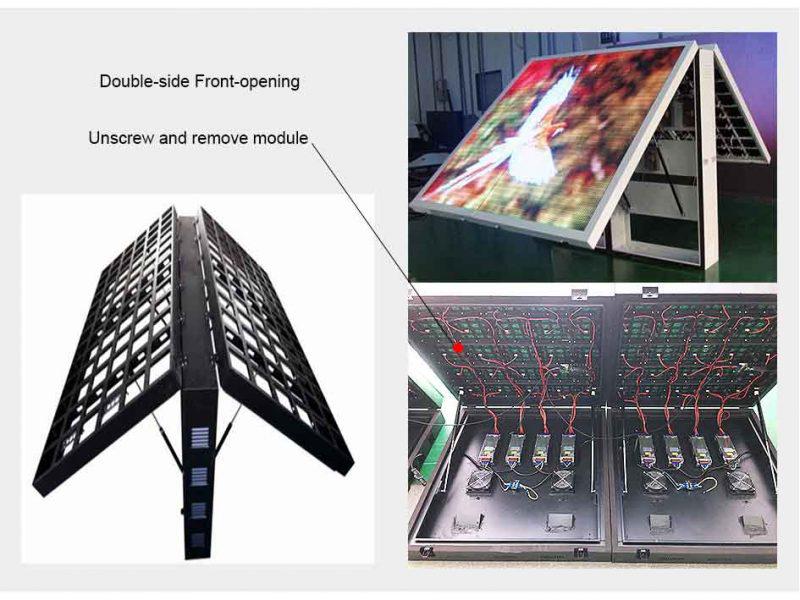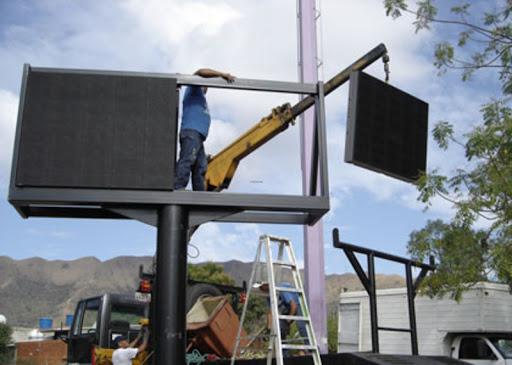What Is a Double Sided LED Display?
A double-sided LED Display refers to a type of LED display that consists of two LED Displays positioned back-to-back. This configuration is enclosed in a robust and durable cabinet designed for easy transport and installation. The arrangement allows the content on both LED Displays to be visible from either side.
These double-sided LED displays produce bright, high-contrast visuals, ensuring clarity even in direct sunlight. As a result, the displayed content remains optimal regardless of the surrounding lighting conditions.
Features of a Double Sided Screen
To gain a deeper insight into double-sided LED Displays, let’s explore the key features offered by this versatile LED display.
Dual Display Feature
A double-sided LED Display consists of two displays integrated into one unit. These LED Displays are available in various sizes and resolutions, typically featuring impressive LED technology. It is essential for both LED Displays to have identical sizes and resolutions to maintain a cohesive look. Additionally, many models come equipped with dual speakers to enhance their functionality. Depending on your needs, you can also opt for higher-quality LED Displays for an improved viewing experience.
Single Cabinet Design
The dual LED Displays are integrated within a single cabinet to form a cohesive unit. Specialized cabinets are available to accommodate two LED displays simultaneously. These cabinets are typically designed to be sleek and lightweight, ensuring that the overall unit remains manageable for both installation and transportation. Additionally, they are robustly constructed to support the combined weight of the two displays.
LED Control Card Functionality
For a double-sided LED Display, an LED control card is utilized. Depending on the LED Display’s configuration, it is possible for both displays to operate using a single control card, which will necessitate a partition control for proper functionality.
These control cards are often designed for a plug-and-play experience, allowing users to easily upload content via USB. An upgrade option to connect to a network is also available, enabling internet access to manage and stream the content displayed on the LED Displays.
Multiple Installation Choices
Similar to other LED displays, this type of LED Display offers a variety of installation methods. For double-sided LED Displays, they can typically be suspended or installed on a stand within the selected venue.
Why Double-Sided LED Display Outshine Single-Sided Displays
The saying “two is better than one” perfectly applies when evaluating double-sided LED Displays versus single-sided ones. If you’re contemplating the advantages of choosing a double-sided LED display, consider these compelling points:
- You receive two LED displays with just one purchase.
- Increased visibility and broader audience engagement.
- Typically designed in a modular format, making them convenient for transportation and logistics.
- Quick to set up and take down.
Applications of Double-Sided LED Display
Similar to other types of LED displays, double-sided screens have a wide range of applications. The most prominent use is in marketing and promotional activities. Additional applications include:
- Live streaming for sports events
- Displaying information in airports and railway stations
- Showcasing at trade shows and exhibitions
- Advertising in shopping centers
- Utilized in commercial buildings
- Information dissemination in banks
These double-sided LED screens are frequently employed for advertisements, product showcases, or sharing essential information. The primary objective is to maximize audience reach.
Guide to Installing Double-Sided LED Displays
Installing a double-sided LED screen requires some technical knowledge. If you lack this expertise, it may be best to engage professionals for the job. Below is a straightforward step-by-step guide to assist you with the fundamentals.
1. Preparation: Gather all necessary tools and equipment before starting. Ensure you have the right protective gear.
2. Site Assessment: Evaluate the installation location for adequate support and power supply. Make sure it meets the weight and size specifications of the screen.
3. Mounting Frame: Assemble the mounting frame securely. This frame will hold the double-sided screen in place.
4. Cable Management: Organize and route the power and data cables in a way that prevents damage and clutter.
5. Screen Assembly: Carefully attach the double-sided panels to the mounting frame. Ensure they are aligned and secured properly.
6. Power Up: Connect the screens to the power source and check all connections.
7. Testing: Once powered, run a series of tests to ensure both sides display images correctly.
8. Final Adjustments: Make necessary adjustments to picture quality and settings.
9. Maintenance Tips: Keep in mind regular maintenance checks to ensure longevity and performance.
By following these steps, you can successfully set up a double-sided LED screen. However, if you feel uncertain at any point, consider consulting experienced professionals.
Conclusion
Opting for a double-sided LED displays comes with its own set of considerations. You will be working with two LED displays, unlike a standard single-display setup. This entails a higher investment and additional concerns regarding installation and upkeep of the LED displays.
Nevertheless, the dual display offers significant advantages. You can enjoy double the visibility and target audience engagement, potentially leading to increased profits. Furthermore, a double-sided LED displays occupies less space while effectively delivering the results you aim to achieve.
Post time: Nov-18-2024










